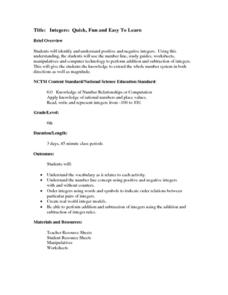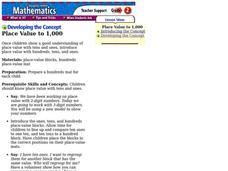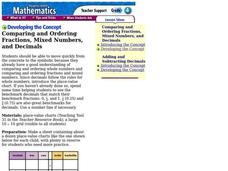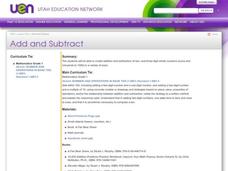Curated OER
Add It Up In Number Ville! Adding 2-Digit Numbers With and Without Regrouping
Young scholars explore adding 2-digit numbers. In this math lesson, students identify 2-digit numbers and use base ten blocks to practice adding. Young scholars use addition to break a code.
Curated OER
Napier's Rods
Young mathematicians explore the concept of multiplication using Napier's Rods. They use Popsicle sticks to create a 3D model of Napier's Rods. Pupils multiply multiple digit numbers using Napier's Rods.
Virginia Department of Education
Mathematics Vocabulary Cards - Grade 1
Clarify basic math concepts with a series of vocabulary posters designed for first graders. The cards include illustrations for fractions, place value, tally marks, and number lines, as well as many more vocabulary words.
National Security Agency
Integers: Quick, Fun and Easy To Learn
A good complement to any integers unit contains a three-day lesson plan about positive and negative integers, adding and subtracting integers, and how to find the additive inverse. Additionally, it provides all necessary...
Curated OER
Tenths and Hundredths - Reteach 21.1
Learners review explanations and models, use grid paper to draw models to show fractions and decimals, and convert them. Pupils solve sixteen problems.
Curated OER
Tenths and Hundredths - Homework 21.1
Fourth and fifth graders write fractions and decimals to describe models, draw models to show fractions and decimals, convert factions and decimals, and answer a word problem. They write twenty-seven answers.
Curated OER
Place Value to 1,000
Second graders study the concept of place value with hundreds, tens, and ones. In the place value instructional activity, 2nd graders demonstrate their prior knowledge of place value with tens and ones. Students are then introduced to...
Fraction Bars
Subtraction of Decimals
Here is a fabulous instructional activity on subtracting decimals with different numbers of decimal places. There are teacher-led activities for learners to engage in, including, modeling decimal subtraction through decimal squares,...
Curated OER
Place Value for Whole Numbers
Fourth graders, in groups, explore place value for whole numbers. They explore how to use base-ten materials to make sense of place value in the tens and ones column. They also explore whole-number patterns by using base-ten materials.
Curated OER
Number Sense
First graders practice rounding 4 digit numbers using place value concepts. In this estimating sums and differences activity, 1st graders explore clustering, rounding, and front end estimation as methods for rounding decimals.
Virginia Department of Education
Integers: Addition and Subtraction
Young mathematicians construct their own understanding of integers with an inquiry-based math lesson. Using colored chips to represent positive and negative numbers, children model a series of addition and subtraction problems as...
West Contra Costa Unified School District
Adding Numbers
Support math instruction at home with a helpful reference sheet designed for parents. Three pages cover the subject of addition with written details and labeled pictures.
Curated OER
Understanding Place Value
In this understanding place value worksheet, students, with a partner, problem solve and calculate the answers to seven place value exercises.
Curated OER
Comparing and Ordering Fractions, Mixed Numbers, and Decimals
Learners practice comparing and ordering fractions, mixed numbers, and decimals. In this fractions, mixed numbers, and decimals instructional activity, students examine a decimal place value chart compared to a whole number place value...
Curated OER
Expanded Form and Place Values
Third graders write a number in their journals that the teacher dictates. They use place value tents to make the number and write it in expanded form. Next, they repeat the process before making numbers that are more or less than the...
Curated OER
Place Value
Second graders use physical models to represent and demonstrate place value concepts by using base-ten blocks and hundreds charts. They compare numbers to see which number is smaller or larger and put numbers in order from smallest to...
Curated OER
Add and Subtract
Like the cubs in A Fair Bear to Share, your 2nd grade class will practice adding and subtracting double-digit numbers by grouping, regrouping, and sorting a collection of objects. This requires many resources, but it is well worth the...
EngageNY
Estimating Digits in a Quotient
Boiling down any division problem to a one-digit divisor problem sure makes estimation easy. The lesson shows how to estimate division problems by using place value understanding and basic arithmetic facts to simplify the division. Some...
Curated OER
Rounding Off and Approximation
In this rounding worksheet, students round numbers to the given place value. They draw models of each given situations. This one-page worksheet contains 8 problems.
Illustrative Mathematics
Number of the Day
Daily routines not only help to manage classrooms, they can also provide students with rich opportunities for learning. This activity supports young learners in developing their number sense by counting up the school days on a class...
Curated OER
Investigation - Who is Right?
Third graders investigate two mathematic scenarios and determine which is correct. They compare adding columns and places (such as the tens place, hundreds place, and so on) and familiarize themselves with how to add larger numbers.
Curated OER
Adding Decimals
Explore the practical uses of adding numbers with decimals as scholars add measurements and money. The first 12 equations are written vertically with half the sums requiring a dollar sign and half a unit of measurement. The next six are...
Curated OER
Junk Yard Math
Third graders explore the process of place value and subtraction through regrouping and borrowing exercises. Several activities using manipulatives are utilized in the instructional activity.
Curated OER
Decimal Models
Before jumping into numeral decimals, explore them visually using this base 10 strategy. There is a set of examples to help scholars understand the concept. They color in grids to represent decimals written in a variety of ways. Some...

























